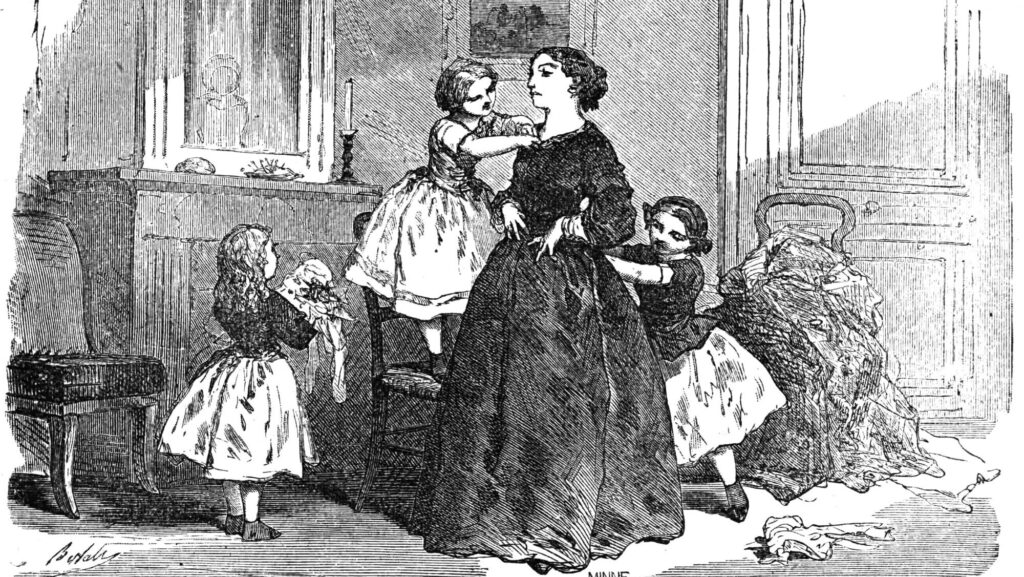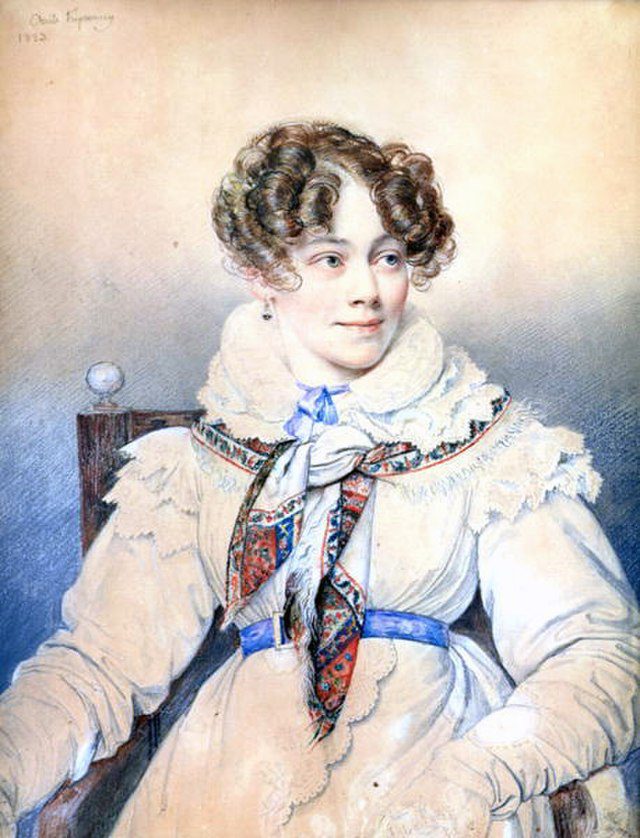
Illustration contained in the novel Les Petites Filles Modèles by Sophie Rostopchine, Comtesse de Ségur.
This year, French literature celebrates the 150th anniversary of the death of the Comtesse de Ségur, author of children’s books that have been classics for generations of French boys and girls. But the venerable countess now gets bad press: she is criticised for being Catholic, reactionary, and confined to a backward-looking vision of an idealised paternalistic society. And yet she has much that ought to appeal to the modern world—a woman of letters who made her living from her pen in a century of men. Her inexhaustibly rich works are among those treasures that must be saved from contemporary savagery, which would dream of burning them in the fire or emptying them of their substance.
I owe a great deal to the Comtesse de Ségur. I was lucky enough to be able to read from an early age. And as soon as I’d got past the basics and immersed myself in more substantial reading, I devoured the collection of writings that this noble lady composed over the years for her many grandchildren growing up in Second Empire France.
Thanks to her prolix pen, my daydreams were soon filled with beautiful homes filled with the graceful laughter of eternal holidays, where cousins met up and lost themselves in serious games under the watchful eye of indispensable nannies—English ones, of course. I walked alongside her heroes, whose names were Paul and Sophie, Camille and Madeleine, Jacques and Eugène. The young ladies wore ravishing lace trousers, and the young men proud sailor suits. Like them, I dreamt of drinking tea from delicate china sets. With them, as I read the pages, I built huts and showered roses on the country lanes in honour of the Blessed Sacrament and the Virgin Mary during magnificent Corpus Christi processions.
It’s hard to imagine that all these enchanting childhood scenes were conjured up in the mind of a little girl from the Russian aristocracy, whose childhood was austere and cold.
The countess’s destiny was unique. Before bearing the haughty name of Ségur—one of the most illustrious of the ancient French nobility—Sophie was born Rostopchin, as she proudly proclaims in the prefaces to her novels. She was born in a palace in Petersburg in 1799. Her father was none other than Fedor Vasilyevich Rostopchin, who set fire to Moscow in defiance of Napoleon Bonaparte’s armies. Like other members of the Russian nobility, Fedor Rostopchin had Mongol blood in his veins—from the time when Russia lived under the yoke of the Golden Horde. It is said that Genghis Khan was his ancestor. Of him Sophie has retained a certain… impetuosity.
She had an unhappy childhood. Her mother, Catherine Protassova, inflicted on her treatment of a rare rigour that provided Sophie with an inexhaustible source of inspiration for the abuse that the unfortunate children in her novels would have to endure. As a daughter of the nobility, she was yet often cold and hungry. But Sophie found solace in the lively tales told by her father, an outstanding storyteller who fed her imagination. She grew up on the vast estate of Voronovo, just a stone’s throw from Moscow, surrounded by horses, wolves, and forests filled with extraordinary and fiery creatures.
In the Europe of the Congress of Vienna, Count Rostopchin—after having burnt down Moscow—ends up leaving Russia, first to go to Vienna, and then to Paris. Sophie followed her father and settled on the banks of the Seine in 1817. It was here that she met Eugène de Ségur, who was to become her husband. He was heir to one of the oldest and most prestigious houses of the French nobility. The Rostopchines’ fortune was immense and welcomed with interest by the Ségurs.

Parisian life and its worldly codes were hard to bear for a young woman used to wide open spaces and Russian exuberance. She was suffocating in Paris. Her father, aware of her discomfort, offered her the ravishing Château des Nouettes, on the edge of Normandy. Fleeing the frivolous life that was the delight of her fickle husband, it was here, in this rural haven that she soon began to love passionately, that the countess invented her stories.
Her marriage to Ségur was not a happy one, but Sophie gave birth to no fewer than eight children, who soon became parents too. She inherited her father’s love of stories, and she enchanted the court of her beloved children, who flocked around her to hear her tell them; she told them so well! When the children and grandchildren moved away, she began to write, first for them alone, then for the public. The honourable grandmother was 57 when her literary career began.
The talent of the Comtesse de Ségur met that of a businessman, Louis Hachette, a renowned publisher. Sophie’s dowry was desperately missing, and Hachette made her a tempting offer: he needed to supply with children’s books his Bibliothèque des chemins de fer (Railway library), which he was setting up in France on the model of what was being done in England. Her work would be perfect for the job. The Pink collection was born—pink, to distinguish it from the other sections offered to readers, such as green for history or red for travel books. Since then, people have stubbornly insisted that this ‘pink’ was a sign of the countess being stuck in gender stereotypes. Of course, nothing could be further from the truth.
Her tales are not simply stories for the amusement of children. Her lively pen paints an extraordinary picture of French society during the Second Empire. In a stroke of literary providence, Sophie de Ségur was the exact contemporary of Pushkin and Balzac. Her work bridges the gap between the legitimist Balzac’s Comédie humaine collection, which depicts Restoration society, and the republican Zola’s Rougon-Macquart, an activist of the Third Republic. Better than anyone else, and before so many others, the countess sensed the profound changes that were sweeping through rural France at the time. In Les Bons enfants (Good Children), she depicts a rural society organised around the château, the estate, and the church—the centre of gravity of a small world that knew it could count on its immemorial protectors, the local nobles, to ensure its prosperity and salvation. But Sophie is clear about the corrosive effects of the industrial revolution. In La Fortune de Gaspard (Gaspard’s Fortune), she casts a harsh light on the growing stranglehold of the factory and its deadly profits, shattering traditional solidarity. Gaspard, the hero, equipped with the baggage of education, climbs the steps to fortune while cynically denying his land and his morals.
But Gaston de Ségur, the countess’s beloved son who had entered the priesthood, was there to watch over her. He tempered his mother’s ardour and insisted that redemption would always come to redeem the worst of the lost heroes invented by Sophie’s tormented soul. It is her son’s faith, as much as her own, that shines its reassuring light on her writings. The countess didn’t fail to add a Gospel to her series of beautiful stories, for the edification of the souls of her dear little ones.
This, of course, was enough for some to label her books as bondieuserie—dismissing them as overly-pious literary kitsch. Yet there is never anything caricatured in her writing. Her vision of childhood, which deserves to be rediscovered, is a model of balance. It shows how repressive and violent upbringing can drive little ones to malice, while gentleness conquers hearts and softens the most resistant. But parents who spoil their children to excess are just as guilty as those who shamelessly beat them. She teaches, without respite, that hope is the order of the day and that tender years spent in misfortune should never prevent virtue from blossoming, even belatedly.
And it is in the face of this tremendous woman, who had the audacity, in the heart of a rather cautious nineteenth century, to sign her own contracts and make a living from her pen, that progressive modernity endlessly pours out its sarcasm. For some, the Comtesse de Ségur is the hated embodiment of a rancid conservatism that libraries need to be rid of. Fortunately, some contemporary critics with a literary heart and sensibility recognise her genius. “The Comtesse de Ségur is the Balzac of youth. She wrote the Comédie enfantine in twenty volumes, all of which are masterpieces. Like Balzac, she writes in the light of two torches: religion and the monarchy,” academician Jean Dutourd wrote in 1994. Today, psychoanalyst Caroline Eliacheff pays tribute to her incredible ability to understand the inner workings of the child’s soul.
On our family bookshelves, an edition of her complete works has pride of place. The covers are worn from being touched by little (and large) hands. Which of the countess’s titles do I prefer? Her most famous trilogy, of course: Les Malheurs de Sophie (Sophie’s Misfortunes), Les Petites filles modèles (Good Little Girls), and Les Vacances (Holidays)—the enchanted paradise of childhood friendships. I confess to having a tender passion for L’Auberge de l’Ange gardien (The Angel Inn)—a touching account of the saga of two little orphans that begins on the roads of France and ends in faraway Russia. There is so much to discover.
Sophie de Ségur, born Rostopchin, gave up her soul to God on February 9th, 1874, at the honourable age of 74. 150 years later, against all odds, she continues to enchant. Her twenty or so novels have sold nearly 30 million copies.
On her grave, dug in the soil of Brittany, we read the most wonderful of epitaphs: “Dieu et mes enfants” (“God and my children”).
With the kind help of my mother, Élisabeth Rossary—the best expert on the countess I’ve ever met!